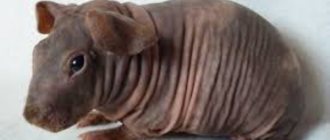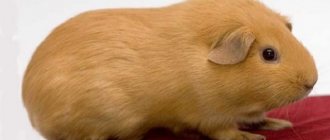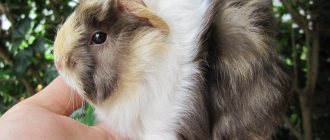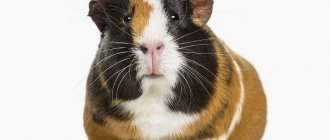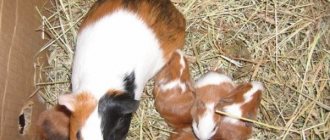Origin
Skinny is a relatively new breed. Naturally, animals with such data cannot live in the wild. In 1978, within the walls of the Armand Frapper Institute, in Montreal, Canada, the fact of a new mutation of a hairless pig, which appeared naturally, was officially recorded and described. This is where the history of the breed could have ended if the phenomenon had not repeated itself in 1984. The bald white pig gave scientists the idea of breeding radically hairless pigs.
As a result, the first female was given the nickname Skinny. Later this nickname grew into the official name of the breed. Translated as skin and bones.
The first hairless animals bred were used exclusively for dermatological research. Their immune system is similar to humans.
Scientists worked hard on the breed, increasing the animal's endurance. To strengthen immunity at the genetic level, she was crossed with selfies. As a result, the animals left the walls of the laboratory and ended up in the homes of guinea pig lovers with a fairly strong immune system. However, even today, Canadian breeders recommend updating the skinny's blood every two generations to maintain the animal's immune system.
At first, only rich people could afford to buy this exotic breed, as the price for them was off the charts. Over time, they spread throughout the world.
Story
It is noteworthy that many of us still have no idea about the etymology of the name “guinea pig” when it comes to a land rodent. In the nations of the world, this name has many variations, one way or another tied to the word “pig”, only the location changes, some call it Guinean, others Indian or Dutch. Depending on the country, the geographical location of the guinea pig also changes.
However, the real homeland of guinea pigs is South America. Since ancient times, people have tamed these animals, discovering their calmness in captivity.
These days we have many varieties and breeds of these cute rodents, whether they are incredibly fluffy long-haired specimens or hairless and defenseless Baldwins and Skinnies. The two breeds differ in their origins, while the Skinny was created through natural mutation in 1976, and the Baldwin did so a full 12 years later.
An interesting fact is that two hairless guinea pigs may well have offspring with hair, but the genes of a hairless guinea pig will already be embedded in the pedigree, which means that the next offspring will be able to contain such piglets.
At the beginning of breeding, the process of producing a large population of this breed took scientists a sufficient amount of time, precisely because not every litter was accompanied by hairless offspring. At first, the hairless little cubs were perceived as a dangerous gene mutation that could lead to illness and degeneration. The first recorded litter of this breed was completely destroyed, however, none of the breeders suspected that a similar gene existed in the parents.
The first hairless guinea pigs had very light skin tones and red eyes. Being albinos, they had a rather weak body, but over time, the bodies of their relatives became stronger and stronger.
Appearance
A feature of the breed is the absence of hair. That’s why they are sometimes called “sphinxes”, as cats with similar external features.
However, this pig still has a very delicate, unnoticeable fluff on its skin, which is very pleasant to the touch. Wool is present in small quantities on the nose and on the paws.
An adult male is up to 35 cm long, a female is smaller. At the withers the height is no more than 6.8 cm. But in weight, a skinny guinea pig reaches one and a half kilograms or more.
The head is large, the ears are round and hanging. The body on some specimens is “folded”. The eyes are expressive and beautiful.
The first Skinnies were pink. As a result of crossing, they acquired not only immunity, but also a color that can be anything. Popular are chocolate, gray, sand, tortoiseshell. The black pig looks very beautiful.
Health and life expectancy
When skinny pigs were first bred, due to inbreeding, hairless offspring were born weak and non-viable. Now the situation has changed.
Guinea pigs of this breed live 5-8 years. True, the lack of fur still affects their health. They are more susceptible to colds than their furry relatives.
A common skinny disease is malocclusion. Due to the pathological structure of the teeth, the pig eats very slowly and has difficulty chewing food. This problem cannot be ignored - it can lead to oral injuries and exhaustion.
Breed standards
Skinny is considered a very rare breed. Standards for it were developed in 2008.
Compliance with the breed at exhibitions is assessed by the build, shape and structure of the head, eyes and ears, the presence of hair in the right places, outer cover and general condition:
- In terms of build, the skinny is a well-fed animal with well-developed muscles;
- the body has good proportions;
- the chest is powerful;
- paws are straight and short;
- the bridge of the nose is slightly curved;
- eyes are large and sparkling;
- ears are flat;
- the coarse fur on the nose should not extend beyond the eyes;
- skin with folds feels pleasant, smooth and warm to the touch, there should be no damage, no stickiness or dandruff.
Special attention is paid to the condition of the skin. Fatness, but not obesity, indicates that the animal is well developed.
Distinctive features of hairless breeds
Hairless guinea pigs are a developed breed, which gives them some characteristics:
- Do not expose your pet's skin to direct sunlight. The delicate epidermis can easily get burned, which can ruin the life of the animal.
- As mentioned earlier, these rodents cannot stand the cold, and temperatures below 22 degrees are completely dangerous to health.
- The body of these creatures has a temperature of 38–39 degrees Celsius.
- The absence of fur provokes a greater consumption of calories spent on maintaining body temperature.
- Hairless guinea pigs are completely hypoallergenic.
- The lifespan of this bred breed exceeds the norm for ordinary animals by several years.
Maintenance and care
It is very important for a pet what kind of housing it will have. It is recommended to purchase a cage made of plastic or metal. It's easy to keep clean. The size should not be small, from 0.6 square meters. meters for one animal.
The bottom should not be lattice, otherwise the rodent will damage its paws. The floor is covered with sawdust with a layer of one and a half centimeters. They are changed regularly. The cage is equipped with a drinking bowl, feeding trough, and accessories for games and relaxation.
An aquarium is not suitable for pigs, as the air there is stagnant. The temperature inside is elevated, gas exchange is weak and the pig is constantly breathing in the vapors of its waste products. This shortens the animal's life.
The only advantage of the aquarium and the “dune” is that naked pigs do not freeze there. For the hairless animal to feel comfortable, it needs 24 degrees of heat.
The pig usually does not climb walls and ladders; the weight gets in the way. The length of the cage is chosen to be at least a meter long.
Be sure to put up a house so that the pig can retire from time to time, with a height of at least 8-10 cm. The house can be stretched from edge to edge of the width of the cage; it should be about 200 mm long. The cage should not be placed in a draft, near heating radiators.
Regularly replacing the bedding, especially in the corners that the animal has chosen for the toilet, will rid the cage of odor.
Nutrition
Skinny's food list should include high-quality hay, grains, vegetables, fruits, roots, lush greens and pellets.
Feeding rules:
- The animal should always have hay lying around. It helps grind teeth. Musty, stale hay should absolutely not be given to animals. Grain hay is recommended rather than legume hay.
- Grain or other dry food is poured into the feeder no more than 2 tablespoons per day. Ready-made herbal pellets should also be present in the diet.
- Juicy food is added as it is eaten. These are carrots, apples, lettuce, pumpkin. Sweet bell peppers are very useful for replenishing vitamin C.
- The drinking bowl should always be filled with water. The animal drinks approximately 250 grams of liquid per day. For females who bear offspring, the norm is increased.
- Treats for skinny are cookies (low-fat dry), crackers, nuts, natural dried fruits without additives.
- Potatoes, eggplants, avocados, garlic, radishes, radishes and mushrooms do not need to be given to the pig.
To make your pet feel full, you can sometimes additionally cook liquid porridge from tasty cereals in water.
To support immunity, vitamins can be added to the water. This water is poured with the expectation that the animal will drink it immediately. Sometimes they practice feeding vitamins to the pig from a syringe.
What to feed your pig
The diet should be varied, while the basics remain the basics. It is changed and supplemented from time to time, but certain products must remain unchanged.
Remember, guinea pigs only eat fresh food. Spoiled food can seriously harm your health. Monitor the quality and freshness of the food.
Based on the advice of experienced owners, we have compiled a small list of products that should be on the menu of every pig:
- Apples;
- Carrot;
- Parsley and dill;
- Granular feed;
- Lots of hay;
- White cabbage in small doses.
In season, the menu is complemented by cucumbers, zucchini, cauliflower, fresh herbs and carrot tops. Let's take a closer look at what guinea pigs eat.
Vegetables, fruits, greens
In order for your guinea pig to receive the fullest possible dose of nutrients, the diet must be varied and supplemented. We recommend alternating several types of products.
It is recommended to feed the following vegetables:
- carrots, beets and their tops;
- zucchini and pumpkin;
- rutabaga and turnip;
- cauliflower and white cabbage in small doses;
- Bulgarian pepper;
- green peas with pods;
- cucumber and tomato.
Be careful with store-bought products. They are grown with pesticides and treated with chemicals for longer storage.
From fruits, guinea pigs are fed:
- Fresh and dried apples;
- Occasionally they give berries;
- You can give citrus fruits from time to time;
- Pears only in small doses so as not to burden the stomach.
In theory, pigs eat cherries, plums, peaches, apricots and nectarines. But you need to be careful here, the composition often contains chemicals.
You can include various salads in your daily diet:
- watercress;
- head lettuce without base and core;
- lettuce leaves without petioles;
- Beijing salad without the bottom of the cabbage leaves.
Optimal weight and walking
Skinny pigs eat 2 times more food than their “woolen” counterparts. This helps maintain an optimal weight so as not to freeze.
To prevent the animal from becoming obese, it is necessary to provide conditions for walking.
The cage should be large or an enclosure should be built next to the home, where the animal could run and play.
If possible, you should let Skinny walk around the apartment under supervision so that she does not get into a place that is unsafe for her.
Animal care
Skinny pigs are easy to care for. Does not shed, no need to comb.
What should you do regularly? Trim the animal's nails so that it does not accidentally scratch itself. The wound can easily become infected. And this is dangerous for skinnies.
Once every three weeks, clean the animal’s ears and wash the animal’s eyes with clean boiled water using a cotton swab.
Bathing this animal is not recommended. If the pig is very dirty, just wipe the skin with a damp cloth that does not contain fragrances.
What do they eat
Skinnies are herbivores. They love hay with greens. Skinnies are coprotrophs; they feed on their own excrement.
It is necessary to add vitamin C to animal feed, since the animal’s body is not able to produce this vitamin on its own. You can purchase this vitamin in liquid form and add it to water or include green and red peppers in Skinny’s diet. But green peppers are more suitable for daily feeding, as they contain less sugar. Several times a week the pig is given 2 leaves of cabbage. Skinny should be given mint and broccoli once every 7 days.
To maintain the balance of vitamins in the mammal’s body, you should feed it cucumbers and tomatoes, apples and citrus fruits, as well as spinach and beans. Skinnies need phosphorus, so they should be given oats and barley a couple of times a week. Pregnant females should be pampered with nuts and seeds more often. But there are foods that are strictly contraindicated for mumps. These are potatoes, meat and chocolate, any fried foods and sweets.
The first time after birth, the young need mother's milk and, if the pig is rejected by the mother, it must be fed manually using a teaspoon. A syringe cannot be used, as the animal may choke. You can feed your pig with goat's milk or formula.
Behavior
Skinnies are very gentle creatures, they are distinguished by emotional sensitivity. This is a socialized animal, unusually affectionate, never bites, and can show excessive curiosity.
Reviews from skinny pig owners indicate that the pet is not dangerous for children. Of course, we are talking about healthy and well-fed animals.
They are able to get along well with other pets that are not aggressive.
A guinea pig will never attack birds or conflict with aquarium inhabitants. It is not uncommon for a skinny and a cat to become great friends.
How to choose a skinny guinea pig and how much it costs
Since the skinny is a rare variety, it costs more than a regular guinea pig. The price range ranges from 19–38 dollars per individual. When buying a pet, you need to take into account that breeders may not indicate the cost on the website and in the description they ask you to call the contact numbers to clarify the cost. Buy pets from trusted nurseries, this will protect you from buying an unhealthy animal.
For an ordinary pig, the condition of its coat indicates its health. If it is smooth, shiny, without bald spots and signs of parasites, then the future pet is healthy. When assessing skinny, you need to take into account all other signs of health:
- the animal must be mobile and active;
- the body is moderately well-fed;
- paws must be dry;
- eyes are clear, without discharge;
- no nasal discharge;
- there is no damage to the skin or inflammation;
- the area around the anus is clean, with no signs of recent bowel movements.
Important! Even though your pig is very friendly and playful, you shouldn't pick
him up from his cage all the time. Like every creature, she needs a break from excessive attention. But you can’t leave your pet completely unattended either.
Breeding
To get offspring from a skinny, you need to get a mate for your animal. Organize comfortable living conditions and nutritious meals. Breeding skinny pigs is a simple task.
At 6–8 months, the female is ready to continue the race. Males become sexually mature starting at three months. However, the optimal age for producing offspring is six months for females and 7 months for males.
Pregnancy lasts about 70 days. Throughout this period, the female must be carefully protected from stress and well fed.
Invisible dangers
When you look at the skinny, it seems strong. But this animal is gentle and vulnerable.
If a pig falls from even a small height, its internal organs may be damaged. Often suffers from intestinal rupture.
Since the weight is decent, there is a lot of load on the paws. With improper nutrition, lack of phosphorus and calcium in the body, paws can become bent.
Hypothermia is dangerous. It is not recommended to take your pig outside during the cold season. Sometimes caring owners sew clothes for their pet. But it saves only partly.
Character
Calm, affectionate, friendly and intelligent animals. Many people consider them fidgety, but what would they do without it? After all, life is movement.
Rodents are diurnal, so they will not disturb their owners during their night rest. Even while awake they behave quietly and meekly.
One of those few “pigs” who demand attention to their person. If owners do not have the time or opportunity to communicate with a pig, be sure to get a couple of animals. Otherwise, the poor fellow will suffer from melancholy and loneliness.




